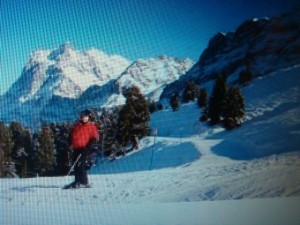
This is the third and final part to Lorie and Gary Sheffer’s amazing story of faith, hope, determination, indomitable will, and especially, Love. Yes, it really sounds to me like a love story. Gary and Lorie passed the test we’d all like to pass, but wouldn’t want to take. Take it away Lorie:
One day a therapist asked the rehab group what their goals were. For one lady it was to be able to go shopping with her daughter, for another it was to make her own lunch, and for one of the men it was to be able to balance his checkbook. When Gary’s turn rolled around, he said his goal was to recover 100%. He wanted to ski, to in line skate, to run, and to return to his job as an engineer. It was around this time that I was taken aside and it was suggested to me that he might need some psychological counseling to help him come to terms with the reality of his situation. I said thank you, but I would rather work with him to reach those goals. Then they suggested counseling for me as well.
Three months after his stroke, I was running along side of Gary around a high school track. The fact that I ran for two miles still amazes us both most of all. We soon learned how insensitive and rude people can be when they see someone with a disability. I choose not to waste space discussing some of what we encountered.
After six months, Gary was able to return to his job. During his absence, they had gotten a new computer aided design system, so he had something new to learn in addition to trying to resume his old duties. Learn it he did. He got back up to speed and received a good performance review from his boss. When he was discharged from HealthSouth, he was still not satisfied with his recovery. Also, ski season was just around the corner. I made good on the promise I had made in the shock trauma unit on the day of his stroke; I got out my skies and we headed to the slopes. Less than a year after the brain hemorrhage, Gary took his first run down a beginner slope. One year to the day after, we took both of our kids out of school and spent the day skiing the slopes where the AVM had burst. Still, he was not satisfied. He went to another physical therapy facility and worked with them for another two years. They discharged him, but he was still not ready to quit. He found a neurological disorders therapy specialist at Johns Hopkins, Bayview Medical Center. She explained that neurological disorders can’t be treated the same as orthopedic injuries. Gary has been seeing her every three weeks for the last nine years, and he is still making progress. He spends time each day working on exercises, most of which are designed to encourage proper body mechanics and automatic use. His motivation is what has gotten him to this point. On our most recent visit to Hopkins, his therapist got a bit misty eyed at the leap he had taken from the previous visit. She said that his gait was perfect. We know that he is pushing her to use all of her skills, and his successes are her successes as well.
Dreams reached: Walking, biking, skiing, speaking, understanding, working, seeing both kids graduate, having a grandchild, seeing our son get married, family vacations, back yard parties, holiday celebrations. My favorites? He now shovels and uses the snow blower, mows the lawn and washes our cars. Truth be told, I love this Gary even more than the person he was before the stroke. He is more patient and worries less about little things. He knows that although we were proud of his achievements, when they were all taken from him we still loved him for who he is and not what he did.
A few years ago, I sent a note to Gary’s neurosurgeon. I wanted to tell him that Gary had skied the Swiss Alps with our son, who is now attending the same medical school as Dr. Krzeminski himself had attended years ago. I enclosed a picture and let him know that anything is possible. I know when he saw that picture, he smiled.